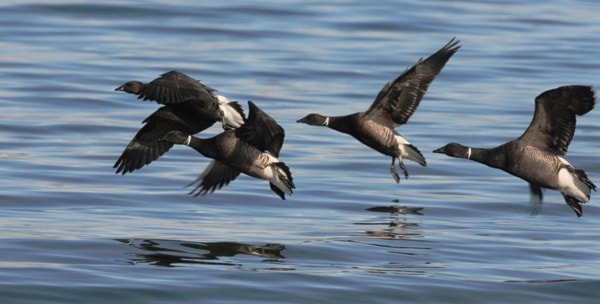In keeping with this winter’s unpredictable weather, March came in with a very loud roar.
Although these late storms wreak havoc on our outdoor plans, they present a far greater problem for the spring migratory birds.
The migration from California and Mexico is well underway and the eastern shores of Vancouver Island from Parksville to Saratoga Beach play a critical part in this process.
For a short time in early March to mid April, our shorelines provide an essential stopover supporting a third of the Pacific flyway water bird population.
The brant geese are one such bird and have very specific needs during their stay. Upon leaving Mexico they fly nonstop close to the shoreline, making a pit stop to refuel their fat and energy levels before continuing to Alaska and the Canadian arctic.
After producing and raising their young they have a few short months to prepare for the long return migration which sees them flying out far over the Pacific Ocean before making their first stopover in southern California.
There are three species of brant geese, the dark-bellied (found mainly in Siberia), pale-bellied (found in Greenland, eastern Canada, and northern Europe) and our local black brant.
Often mistaken for Canada Geese the brant is smaller with a shorter neck, weight is between one and a half and two kilograms. Unlike the Canada goose, brants have a “white necklace” of feathers around the top of their neck and they do not have the white eye patches.
The body of these geese is sooty black with white edging on the feathers; they also have white flank feathers and a white rump.
Brant geese tend to fly in various sized flocks close to the shore and their wings are sloped backwards. Feeding time for brants is very specific — they dine on the ebbing tide when the eelgrass is exposed; they also eat sea lettuce and seaweeds.
They come into the shallow water when daylight breaks and they spend the day close to the shore. As soon as dusk approaches, they head out to the safety of the open water for the night.
Arriving in early March in large numbers brant geese can be seen along the east coast of Vancouver Island. Their arrival coincides with the herring spawn. This high-protein rich food supplements their diet, providing them with extra fat reserves.
For the past 18 years a festival has been held in the Parksville-Qualicum area to celebrate the brants’ return; at the peak of the stopover there can be as many as 20,000 geese.
This year’s festival runs from March 5 until April 19 and includes a wide variety of activities including, wildlife tours and adventures, kids Spring Break Camps, artisans and a bird counting competition.
For a program of events and more information, please check www.brantfestival.bc.ca.
In addition to the Parksville festival, Comox Valley naturalists are setting up their telescopes from a viewing area with an information centre at Goose Spit Park in Comox on April 23 from noon to 3.
We wish for better weather than the gale of 2010!
From March 1 until May 20 there will be special bylaws at the Spit for dog owners. Undisturbed feeding is essential for these birds, as this is their final preparation and chance to finetune their feathers and add to their fat supply.
Often they will arrive at their breeding grounds before the snow has melted and need to be able to sustain themselves until food is available. These birds are very susceptible to human encroachment in their breeding grounds and there is concern for their future if gas and oil sources are developed.
Dogs must be kept on a leash at all times and you are asked to keep dogs away from the water and from under the cliffs and bluffs on Goose Spit. This area will be patrolled so a better option may be using other parks with river or forest trails.
• • •
To report injured wildlife, call toll free 1-800-304-9968, for all other calls 250-337-2021 or www.wingtips.org.
Sandy Fairfield is the educational co-ordinator for the Mountainaire Avian Rescue Society (MARS). The MARS column appears every second Friday.



